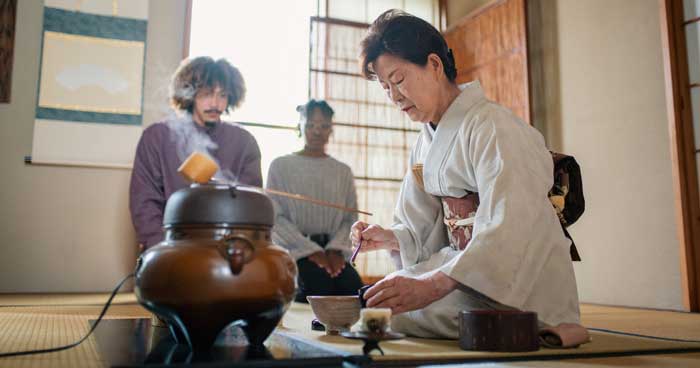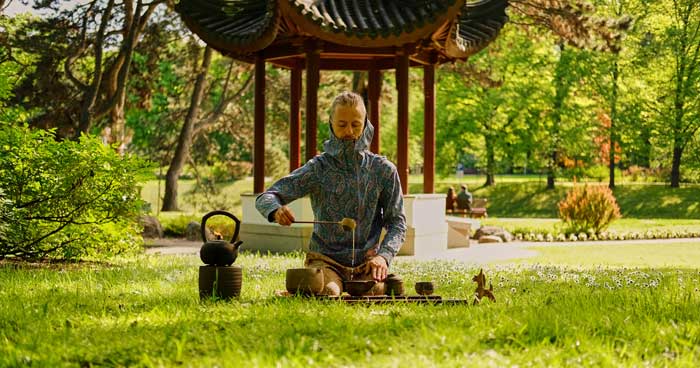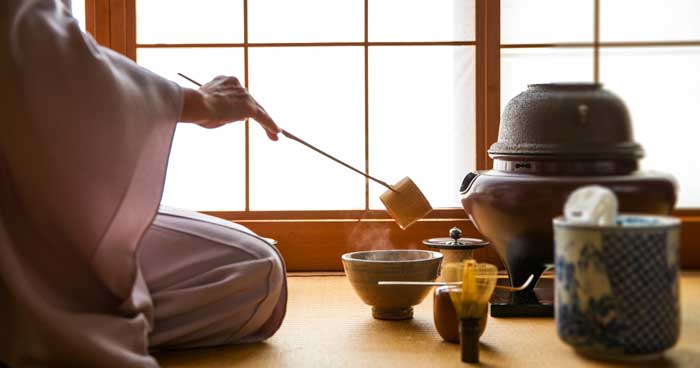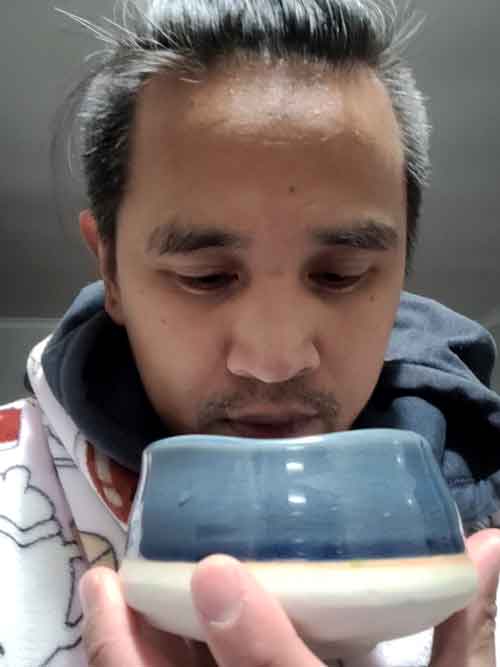Let’s talk about something special called the “tea ceremony.” Imagine you’re stepping into a peaceful, quiet room, where every detail is cared for. This isn’t just about drinking tea; it’s about enjoying a moment of calm and beauty with friends or even by yourself.
The tea ceremony is a tradition from Japan, but it has roots in China too. It’s been around for hundreds of years and is all about slowing down, being respectful, and finding joy in simple things. In this ceremony, making and drinking tea is a way to relax, reflect, and connect with others. Each part of the ceremony, from the way the tea is prepared to how it’s served and drunk, is done with care and thoughtfulness.
So, when we talk about the Japanese tea ceremony, we’re diving into a rich, calming tradition that’s much more than just sipping on tea. It’s about bringing a little piece of tranquility into our busy lives.
Historical Background
Let’s step back in time to explore the roots of the tea ceremony. This unique tradition started long ago, primarily in China. Originally, it was all about enjoying tea for its taste and health benefits. People would gather, brew, and sip tea, finding joy and calmness in the process.
Then, the practice made its way to Japan, where it transformed into something even deeper. In Japan, the tea ceremony became not just a way to enjoy tea, but a spiritual and respectful ritual. It was influenced by Zen Buddhism, which is all about finding peace and understanding in every action. This added layers of meaning to the ceremony, making it a way to show respect, humility, and a love for beauty.
Over the centuries, the tea ceremony has evolved. In Japan, different schools and styles developed, each with their own unique ways of performing the ceremony. But despite these differences, the heart of the ceremony remains the same: a moment of peace, respect, and simplicity.
So, when we talk about the history of the tea ceremony, we’re looking at a journey from a simple tea-drinking practice to a rich cultural ritual. It’s a tradition that has stood the test of time, evolving while keeping its core values intact.
Detailed Procedure of the Tea Ceremony

The tea ceremony, known as “Cha-no-yu” in Japanese, is a traditional ritual that involves the ceremonial preparation and presentation of matcha, a powdered green tea. Here’s a detailed step-by-step explanation of the tea ceremony process, highlighting the importance of each step and how it contributes to the overall experience:
- Preparation of the Tea Room and Garden: The ceremony starts long before the first guest arrives. The host prepares the tea room (Cha-shitsu) and the garden leading to it. The room is cleaned meticulously, and the garden path (Roji) is swept. This preparation symbolizes the clearing of mind and heart for the ceremony.
- Arrival of the Guests: Guests wait in a waiting area (Machi-ai) and proceed along the garden path, stepping on stones placed carefully. This journey from the outer world to the tea room is meant to symbolize leaving the mundane world behind and entering a space of tranquility.
- Purification Ritual: Upon reaching the tea room, guests perform a purification ritual at the stone basin (Tsukubai), washing their hands and rinsing their mouths. This act symbolizes the cleansing of the spirit and body in preparation for the ceremony.
- Entering the Tea Room: Guests enter the tea room through a small door, which requires them to bow, symbolizing humility and equality, as everyone, regardless of status, must bow to enter. The room is designed to be simple and unadorned, focusing on the essence of the experience rather than material wealth.
- Examination of the Tea Utensils: Before the tea is prepared, the host presents the tea utensils to the guests for examination. This part of the ceremony is to appreciate the beauty and craftsmanship of the tea tools, which include the tea bowl (Chawan), bamboo whisk (Chasen), tea scoop (Chashaku), and tea container (Natsume or Chaire).
- Preparation of the Tea: The host then begins the meticulous process of making the tea. Hot water is added to the matcha powder in the tea bowl, and the mixture is whisked with the bamboo whisk until frothy. The preparation is done with precise movements and deep concentration, reflecting the mindfulness and care of the host.
- Serving the Tea: The tea is served to the main guest, who takes a moment to admire the bowl before taking a sip. The guest rotates the bowl before drinking, to avoid drinking from its front, showing respect to the host and the bowl itself. The tea is passed among the guests, each taking a turn to savor the matcha.
- Discussion and Reflection: After drinking the tea, guests and the host engage in a quiet conversation, often about the utensils, the tea, or philosophical topics. This part of the ceremony emphasizes social harmony and cultural appreciation.
- Conclusion: The ceremony concludes with the guests expressing their gratitude for the tea and the host cleaning the utensils once more. The guests then leave the tea room, walking back through the garden, reflecting on the experience.
Each step of the tea ceremony is filled with symbolism and is meant to contribute to an atmosphere of harmony, respect, purity, and tranquility. The process is not just about drinking tea, but about appreciating the moment, the company, and the artistry involved in the ceremony.
Cultural Significance and Symbolism
The tea ceremony is a special tradition from Japan, filled with deep meanings and values. It’s not just about drinking tea, but about finding peace, showing respect, and enjoying the moment. This ceremony is influenced by Zen Buddhism, which is a type of Buddhism focusing on meditation and mindfulness.
Cultural Values and Philosophy:
The ceremony is based on four main ideas: harmony, respect, purity, and tranquility.
- Harmony (Wa): This is all about living in peace with people and nature. The tea ceremony helps everyone feel connected and at peace with each other.
- Respect (Kei): This means showing deep respect to others. During the tea ceremony, everyone is treated with respect, no matter who they are.
- Purity (Sei): This is about being clean in body and mind. Before entering the tea room, people clean their hands and mouths to symbolize this inner purity.
- Tranquility (Jaku): This is finding inner peace. The calm and quiet of the tea ceremony helps people feel more relaxed and peaceful.
Symbolism in the Tea Ceremony:
- Utensils: Every tool used in the tea ceremony, like the tea bowl, tea whisk, and tea scoop, has a special meaning. They are chosen carefully by the host and are used in a way that shows respect and care. The way these tools are used and treated shows the importance of paying attention to even the smallest details in life.
- Movements: Every movement in the tea ceremony is done slowly and with great care. This helps the person making the tea and the people watching feel calm and focused. These movements are a way to show respect for the guests and for the moment.
- The Tea (Matcha): Matcha is a special kind of green tea used in the ceremony. Its bright green color stands for new beginnings and the bitter taste reminds us that life can sometimes be difficult. Sharing matcha during the ceremony is a way to bring everyone closer together, sharing both the good and the tough parts of life.
- Room and Setting: The place where the tea ceremony happens is simple and calm, which helps everyone feel more peaceful. The room is set up in a way that lets everyone forget their troubles and focus on the moment. The decorations, like a scroll or flowers, are simple and reflect the beauty of nature.
In short, the tea ceremony is much more than just making and drinking tea. It’s a way to bring out the best in ourselves and to connect with others and nature. It teaches us to appreciate the simple, beautiful moments in life.
Variations of the Tea Ceremony
Tea ceremonies vary across cultures, each reflecting unique traditions, aesthetics, and philosophies. Here’s a deep dive into the diverse world of tea ceremonies:
- Japanese Tea Ceremony (Chadō or Chanoyu): In Japan, the tea ceremony is more than just drinking tea; it’s a spiritual and philosophical experience, deeply rooted in Zen Buddhism. The ceremony emphasizes four principles: harmony (wa), respect (kei), purity (sei), and tranquility (jaku). It involves precise steps and rituals, from cleaning the tools to serving the matcha (powdered green tea). Each movement and item used in the ceremony, from the tea bowl to the bamboo whisk, carries symbolism and is designed to foster a mindful and meditative state, leading participants to find beauty in simplicity and tranquility.
- Chinese Tea Ceremony (Gongfu Cha): This ceremony highlights the art and skill (gongfu) of tea preparation. Unlike the Japanese ceremony’s focus on matcha, Gongfu Cha typically involves oolong or pu-erh tea. The ceremony uses specific tools, like a small teapot and tiny cups, to enhance the tea’s flavor. Each step, from warming the vessels to pouring the tea, is performed with care and attention to detail, showcasing the tea’s aroma and taste layers. This ceremony is more informal than its Japanese counterpart, focusing on the tea’s sensory pleasures and the social interaction among participants.
- Korean Tea Ceremony (Darye): The Korean tea ceremony is known for its simplicity and naturalness. Darye, meaning “tea etiquette,” is less rigid than the Japanese ceremony and focuses on the peaceful enjoyment of tea within nature. The ceremony encourages a connection with the natural world and reflects the Korean philosophy of living in harmony with nature. The tea used is typically green tea, and the ritual emphasizes the tea’s natural flavors and the serene setting of the tea drinking experience.
- Taiwanese Tea Ceremony: While Taiwan shares some of its tea culture with China, it has developed its own unique ceremony style, particularly with the popularity of oolong tea. The Taiwanese ceremony combines elements of the Chinese Gongfu Cha but often takes place in a more casual setting. It emphasizes the social aspects of tea drinking, inviting conversation and relaxation among friends.
- Moroccan Tea Ceremony: This ceremony centers around the preparation and serving of Moroccan mint tea, a blend of green tea, fresh mint leaves, and sugar. It is a sign of hospitality and friendship, typically performed by the head of the household. The tea is poured from a height to create foam, symbolizing wealth and good fortune. The Moroccan tea ceremony is less formal than East Asian ceremonies, focusing on warmth, hospitality, and the enjoyment of shared time with guests.
- British Tea Tradition: While not a ceremony in the traditional sense, the British afternoon tea is a cultural ritual that has been adopted worldwide. It typically includes a selection of teas, served with scones, sandwiches, and cakes. The focus is on leisure, social interaction, and the enjoyment of tea as a part of daily life.
Each tea ceremony variant reflects its cultural background, values, and aesthetics, offering a unique approach to the appreciation of tea. Whether it’s the meditative focus of the Japanese ceremony, the sensory enjoyment of the Chinese ceremony, the harmony with nature emphasized in the Korean tradition, the hospitality of the Moroccan ritual, or the social leisure of British afternoon tea, each practice offers a window into the culture it originates from and a different way of experiencing the universal pleasure of tea.
Practical Tips for Hosting Your Own Tea Ceremony

Alright, hosting your own tea ceremony might sound like a big task, but it can be a beautiful and serene experience. Here’s some friendly advice to help you get started and ensure everyone has a great time.
Firstly, tea ceremonies are all about respect, cleanliness, harmony, and tranquility. So, when you’re planning to host your own, try to keep these values in mind. It’s not just about the tea; it’s about creating a moment of peace and reflection for you and your guests.
Etiquette and Preparation:
- Cleanliness is key: Before your guests arrive, clean the space where you’ll hold the ceremony. It should be tidy and calm. This doesn’t mean it has to be empty, just that it should feel peaceful and welcoming.
- Dress appropriately: In traditional ceremonies, participants wear simple, respectful clothing. You don’t need a kimono, but wearing something comfortable and modest sets the right mood.
- Know your tools: Familiarize yourself with the tea ceremony utensils like the tea bowl (chawan), tea whisk (chasen), and tea scoop (chashaku). These items are not just tools but symbols of the care and attention you’re putting into the ceremony.
- Tea selection: Choose a high-quality tea for the ceremony. This is usually matcha for Japanese ceremonies. Remember, the tea is a central part of the experience, so go for the best you can get.
- Practice makes perfect: Before hosting your ceremony, practice making the tea by yourself. This way, you can feel more confident when it’s time to perform the ceremony in front of your guests.
Creating the Right Ambiance:
- Natural elements: Incorporate elements of nature into your space. This could be a small branch, a flower, or a stone. These are not just decorations but are meant to reflect the season and create a connection with nature.
- Silence is golden: The tea ceremony is a quiet event. Speak softly and keep background noise to a minimum. This helps create a meditative atmosphere.
- Simplicity and elegance: The beauty of the tea ceremony lies in its simplicity. Avoid overcrowding the space with decorations or unnecessary items.
- Prepare your guests: Let them know what to expect during the ceremony. Explain that it’s a moment to relax and enjoy the simplicity and beauty of the moment.
During the Ceremony:
- Serve with humility and respect: When serving the tea, do it with grace and respect towards your guests. Remember, every movement is part of the ceremony and should be done thoughtfully.
- Drink with gratitude: Encourage your guests to enjoy the tea with all their senses and appreciate the moment fully.
- Clean as you go: After each guest has finished their tea, clean the utensils gracefully as part of the ceremony. This shows respect for your tools and the ceremony itself.
After the Ceremony:
- Reflect on the experience: Allow a moment after the tea is finished to discuss the experience or simply enjoy the silence and reflect.
- Clean up thoughtfully: After your guests have left, take the time to clean all the tools and the space thoroughly. This is part of the ceremony’s respect and helps you conclude the experience on a peaceful note.
Remember, your tea ceremony doesn’t have to be perfect. It’s about sharing a peaceful and mindful moment with friends or family. Embrace any mistakes as part of the learning process and part of the unique experience you’re creating. Enjoy the journey into the world of tea ceremonies, and may your tea be warm and your heart be calm.
The Benefits of Participating in a Tea Ceremony
Engaging in a tea ceremony is more than just drinking tea; it’s a deeply enriching experience that can benefit your mind, body, and soul. Let’s explore how this serene ritual can make a positive impact on your life.
Mental and Emotional Benefits:
- Mindfulness and Focus: Participating in a tea ceremony requires you to pay attention to every detail, from the temperature of the water to the movement of your hands. This focus pulls you into the present moment, helping reduce stress and anxiety. It’s like a form of meditation; as you concentrate on the steps of the ceremony, you’ll find your worries slipping away, clearing your mind.
- Cultural Appreciation and Learning: Engaging in a tea ceremony opens you up to new experiences and traditions. Understanding the cultural significance and history behind the ceremony can deepen your appreciation for other ways of life and perspectives, broadening your mindset.
- Emotional Connection: Whether you’re enjoying a tea ceremony alone or with others, it fosters a sense of peace and contentment. Sharing this moment with friends or family can strengthen bonds, while doing it alone can be a form of self-care, allowing you to reconnect with your inner self.
Social Benefits:
- Building Community and Relationships: When done in a group, a tea ceremony is a shared experience that can bring people closer together. It’s a time to put aside differences and appreciate the company of others, promoting a sense of community and belonging.
- Respect and Etiquette: The ceremony is imbued with respect, not just for the tradition but also for the participants and the environment. This practice can help improve your social interactions outside the ceremony, as you carry this sense of respect into your daily life.
Mindfulness and Relaxation:
- Relaxation and Serenity: The deliberate, slow movements and the quiet environment help induce a state of calm. It’s a chance to slow down from the fast pace of modern life, relax your body, and calm your mind.
- Awareness and Reflection: By participating in a tea ceremony, you’re encouraged to reflect on your actions, thoughts, and the moment itself. This can lead to greater self-awareness and insight, as you contemplate the simplicity and beauty of the ritual.
Overall, participating in a tea ceremony offers a unique blend of mental, emotional, and social benefits. It’s not just about drinking tea; it’s about embracing a moment of peace, reflecting on life, and connecting with others in a meaningful way. Whether you’re seeking tranquility, looking to deepen your cultural understanding, or simply wanting to enjoy a moment of silence, a tea ceremony can offer these experiences and more. So, the next time you have the opportunity, why not immerse yourself in this enriching tradition? It might just offer the pause and reflection you’ve been searching for.
Conclusion
We’ve talked a lot about tea ceremonies, right? We learned that these ceremonies are more than just drinking tea. They’re special traditions that help people find peace, show respect, and enjoy the moment. We explored how different places like Japan, China, and Morocco have their own unique tea ceremonies. Each one shows us something special about their culture.
We went through the steps of a tea ceremony, seeing how each part is full of meaning and care. We also talked about how you can do your own tea ceremony at home, making sure you pay attention to the little details and respect the process.
Plus, we looked at the good things that come from joining in a tea ceremony, like feeling more relaxed, connecting better with friends, and just enjoying the present moment.
Now, here’s what I think: Why not try a tea ceremony yourself? You don’t need fancy tools or a perfect setup. Just start with a cup of tea, find a quiet spot, and take a moment to enjoy it. Think about the warmth of the cup, the smell of the tea, and how it feels to take a slow sip. Invite some friends or family to join you and share the moment.
Experiencing a tea ceremony can be a lovely way to slow down and enjoy the simple things in life. So go ahead, give it a try, and see what you discover. Who knows? You might just find a new way to relax and connect with the people around you.


